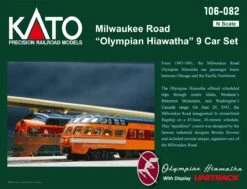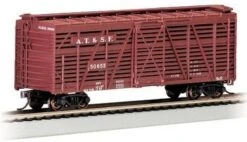$239.99 Original price was: $239.99.$96.99Current price is: $96.99.
- Safe Payments, the Smart Choice
- Online customer care, always here for you.
- Worry-Free Shopping with Safe Payments
- 100% Quality Satisfaction

EMD F-units were a line of diesel-electric locomotives produced between November 1939 and November 1960 by General Motors Electro-Motive Division and General Motors-Diesel Division. Final assembly for all F-units was at the GM-EMD plant at La Grange, Illinois and the GMDD plant in London, Ontario, Canada. They were sold to railroads throughout the United States, Canada, and Mexico.
Structurally, the locomotive was a carbody unit, with the body as the main load-bearing structure, designed like a bridge truss and covered with cosmetic panels. The so-called bulldog nose was a distinguishing feature of the locomotive’s appearance, and made a lasting impression in the mind of the traveling public.
The F-units were the most successful “first generation” road (main line) diesel locomotives in North America, and were largely responsible for superseding steam locomotives in road freight service. Before this, diesel units were mostly only built as switcher locomotives, and only used in rail yards.
F-units were sometimes known as “covered wagons”, due to the similarity in appearance of the roof of an F-unit to the canvas roof of a Conestoga wagon, an animal-drawn wagon used in the westward expansion of the United States during the late 18th and 19th centuries. When a train’s locomotive consist included only F-units, the train would then be called a wagon train. These two usages are still popular with the railfan community.
LOCOMOTIVE FEATURES:
Full cab interior
Wire grab irons
Coupler cut levers
See-through cab windows
Flexible rubber trainline hose
Flexible rubber MU hoses
Windshield wipers
Lift rings
Blomberg-B trucks
Sander lines
Directional constant lighting
Headlight brightness remains constant
Separately applied photo etched metal and injection molded detail parts
Detailed fuel tank with fuel fillers, fuel gauges, breather pipes and retention tanks
DCC-ready features Quick Plug plug-and-play technology with 21-pin NEM connector
Accurately-painted and -printed paint schemes
McHenry scale knuckle couplers – Kadee compatible
Fully-assembled and ready-to-run
Scaled from prototype resources including drawings, field measurements, photographs, and more
Genesis driveline with 5-pole skew wound motor, precision machined flywheels, and multi-link drivetrain
All-wheel drive with precision gears for smooth and quiet operation
All-wheel electrical pickup provides reliable current flow
Wheels with RP25 contours operate on all popular brands of track
LED lighting for realistic appearance-including lit number boards, ground lights, and marker lights (if applicable)
Heavy die-cast frame for greater traction and more pulling power
Packaging securely holds model for safe storage
Replacement parts available
Minimum radius: 18″ – Recommended radius: 22″
SOUND Equipped MODELS ALSO FEATURE
Onboard DCC decoder with SoundTraxx Tsunami2 sound
Dual cube speakers for optimal sound quality
Sound units operate in both DC and DCC
Individual sound boards installed in both A and B units (sound units only)
Engine, horn, and bell sounds work in DC
Some functions are limited in DC
All functions NMRA compatible in DCC mode
Excellent low-speed operation
Program a multiple unit (MU) lashup with lead unit only horn, bell, and lights
Lighting effects such as beacons, Gyralight where prototypically accurate
Many functions can be altered via Configuration Value (CV) changes
CV chart included in the box
ATSF UNITS FEATURE:
Modernized appearance (1959+)
Simulated stainless steel applied to some units per prototype
High or low fans per prototype
Lifting lugs
Back up lights
Dynamic brake vents or 36″ fan per prototype
Nose side grab irons (A-units)
ATS shoes (A-units)
Be the first to review “Athearn Genesis HO G19560 F3B Diesel Locomotive With Sound, Santa Fe #21A” Cancel reply
Related products
Passenger Cars










Reviews
There are no reviews yet.